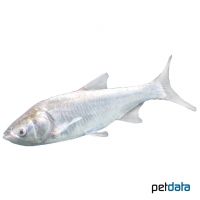Silver Carp (Hypophthalmichthys molitrix)
| Silver Carp Hypophthalmichthys molitrix | |
|---|---|
| Name | Silver Carp |
| Name Lat. | Hypophthalmichthys molitrix |
| Family | East Asian Minnows |
| Family lat. | Xenocyprididae |
| Order | Carps |
| Order lat. | Cypriniformes |
| Origin | Asia |
| Habitat | Rivers |
| Diet | Planktivore |
| pH | 6.5-7.5 |
| Behavior | Peaceful |
| Keeping | Group |
| Care Level | Moderate |
| Reproduction | Egg scatterer |
| Breeding | Difficult |
| Life Span | 5-10 years |
| Protection | No |
| Metric Units | |
| Size | 50-70 cm |
| Temperature | 4-28 °C |
| Hardness | 10-20 °dH |
| Aquarium | Ponds |
| US Units | |
| Size | 20"-28" |
| Temperature | 39-82 °F |
| Hardness | 178-356 ppm |
| Aquarium | Ponds |
Distribution and habitat
Silver carp are native to eastern Asia, where they are widely distributed from the Pacific coast of China to Siberia. They live in deep, slow-moving rivers or large lakes. In Europe and North America they were often released for algae control.
Maintenance
The pond should be furnished with pond, floating and oxygenating underwater plants (milfoil, waterweed, hornwort, etc.), large river pebbles, and a substrate of round-grained gravel and sand, with plenty of free swimming space.
No ammonia, ammonium or nitrite should be detectable in the water, and the nitrate level should not exceed 100 mg/l. To ensure the water quality and oxygen content, a filter adapted to the water volume is necessary.
Diet
Silver carp feed primarily on plant plankton, which they filter from the water using their gill trap apparatus, which is fused into a fine sieve
There should be plenty of algae and plankton in the pond. The food supply consists of a high-quality plant-based food for pond fish (spirulina algae), which is well accepted after acclimation. Occasionally, live food such as bosmids, copepods and cyclops should be offered, which is also usually accepted without problems in frozen form, or alternatively a frozen special food mix.
Only as much should be fed as is eaten in a few minutes. Regular and varied feeding promotes health and increases resistance.
Behaviour and compatibility
They are calm, peaceful and sociable fish that do not show any aggressive or incompatible behavior. At least 5, but preferably more silver carp should be kept together
Basically, only compatible fish species with similar demands on water condition and water temperature should be socialized.
Reproduction and breeding
The sexes are difficult to distinguish, the males are slightly more slender than the females at mating time.
They are free spawners, spawning from May to July over gravelly bottoms in strongly flowing waters at a water temperature of 18-26 °C. After only 2-3 days, the larvae hatch from the eggs drifting downstream and, having used up their yolk supply, feed on zooplankton
As far as is known, silver carp do not reproduce naturally in Central Europe.
Important
The silver carp is not a native species and therefore special care must be taken to prevent it from entering the wild (fauna adulteration!).
They are good jumpers, able to overcome obstacles up to more than 1 m during their river migrations. Silver carp are very suitable for suspended algae control, but the pond water does not become much clearer.
If they are overwintered in the pond, it is necessary to ensure sufficient depth and oxygen supply (filter, oxygen dispenser, ice free holder). At temperatures below 8-10 °C the metabolism of the fish slows down and food is no longer accepted, feeding must be stopped accordingly. If the temperature drops further, they hibernate near the bottom. In spring, with rising temperatures, feeding can slowly be resumed. Feeding may also be necessary during prolonged warm periods in winter.
The well-being of the fish should be monitored regularly. A regular partial water change, according to the pond size is recommended, even if the pollutant load has not yet reached the upper limit. Sudden changes in water quality should be avoided. Newly introduced fish must be accustomed slowly to the water in the pond
Further literature can be found in your pet store.
References
Text: Werner Winter; Image: petdata
Source: BMELV (1998): Tierschutzgutachten - Haltung von Zierfischen (Süßwasser); RIEHL & BAENSCH (2006): Aquarien Atlas Bd. 3, Mergus Verlag; ENGELMANN (2005): Zootierhaltung - Tiere in menschlicher Obhut: Fische, Verlag Harri Deutsch
- Gemäß § 21 Abs. 5 Tierschutzgesetz idgF
